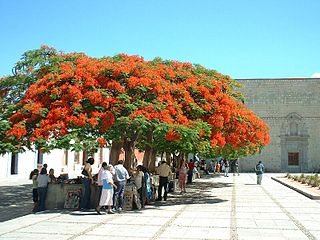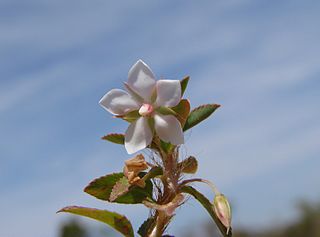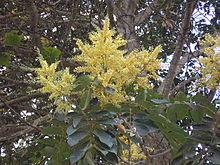
Caesalpinioideae is a botanical name at the rank of subfamily, placed in the large family Fabaceae or Leguminosae. Its name is formed from the generic name Caesalpinia. It is known also as the peacock flower subfamily. The Caesalpinioideae are mainly trees distributed in the moist tropics, but include such temperate species as the honeylocust and Kentucky coffeetree. It has the following clade-based definition:
The most inclusive crown clade containing Arcoa gonavensisUrb. and Mimosa pudicaL., but not Bobgunnia fistuloides(Harms) J. H. Kirkbr. & Wiersema, Duparquetia orchidaceaBaill., or Poeppigia proceraC.Presl

Parkia is a genus of flowering plants in the family Fabaceae. It belongs to the mimosoid clade of the subfamily Caesalpinioideae. Several species are known as African locust bean.

Andira is a genus of flowering plants in the legume family, Fabaceae. It is distributed in the tropical Americas, except for A. inermis, which also occurs in Africa. It was formerly assigned to the tribe Dalbergieae, but molecular phylogenetic studies in 2012 and 2013 placed it in a unique clade within subfamily Faboideae named the Andira clade.

Centrolobium is a Neotropical genus of flowering plants in the family Fabaceae, assigned to the informal monophyletic Pterocarpus clade of the Dalbergieae. The genus comprises mostly large trees to 30 m tall, characterised by an abundance of orange peltate glands that cover most parts of the plant, and fruits that are large winged samaras to 30 cm long with a spiny basal seed chamber.

Copaifera is a genus of tropical plants in the legume family Fabaceae. It includes 40 species native to the tropical Americas, west and central tropical Africa, and Borneo.

Dimorphandra is a genus of legume in the family Fabaceae, subfamily Caesalpinioideae. It includes 26 species native to northern South America, ranging from Colombia and Venezuela to Bolivia, Paraguay, and southeastern Brazil.

Machaerium is a genus of flowering plants in the family Fabaceae, and was recently assigned to the informal monophyletic Dalbergia clade of the Dalbergieae. It contains the following species:

Macrolobium is a legume genus in the subfamily Detarioideae. It is a tropical genus with about 80 species. Half occur in Brazil, where they are common in the floodplains of the Amazonian Basin. Members of the genus are used as ornamentals and for their wood.

Ormosia is a genus of legumes. 131 living species, mostly trees or large shrubs, are native to the tropical Americas, from southwestern Mexico to Bolivia and southern Brazil, to southern, southeastern, and eastern Asia, and to New Guinea and Queensland. Most are tropical, while some extend into temperate temperate regions of China. A few species are threatened by habitat destruction, while the Hainan ormosia is probably extinct already.

Platymiscium is a genus of flowering plants in the family Fabaceae, and was recently assigned to the informal monophyletic Pterocarpus clade within the Dalbergieae. It has a Neotropical distribution, from northern Mexico to southern Brazil. Platymiscium is the only genus in the family with opposite leaves in all its species. Its wood has various uses, mostly for constructions and furniture. It's wood is also sometimes referred to as Granadillo, Macacauba, Macawood, Hormigo, or Orange Agate.
Tachigali beaurepairei, synonym Sclerolobium beaurepairei, is a species of legume in the family Fabaceae. It is endemic to Brazil.

Tachigali densiflora, synonym Sclerolobium densiflorum, is a species of flowering plant in the family Fabaceae. It is found only in the Alagoas, Bahia, and Pernambuco states of Brazil. T. densiflora has recently suffered from severe habitat declines and is ranked near threatened by the IUCN.

Swartzia is a genus of flowering plants in the family Fabaceae. It was named in honor of Swedish botanist Olof Swartz and contains about 200 species. Swartzia is restricted in its geographical distribution to the New World Tropics, where it occurs primarily in lowland rainforests, but also in savannas, pre-montane forests, and tropical dry forests. While it can be found throughout the wet lowlands from Mexico and the Caribbean islands to southern Brazil and Bolivia, Swartzia is most abundant and species-rich in Amazonia, where 10–20 species may co-occur at a single site. The species of Swartzia are mostly trees, ranging from small understory treelets to large canopy emergents. Some species, especially in savannas, are mult-stemmed shrubs.

The Legislative Assembly of the State of São Paulo is the unicameral legislative branch of São Paulo state in Brazil. The building where the legislative assembly is located, right by the main park of the city, also houses one of six Poupatempo units in the city.

Sauvagesia is a genus of plants in the family Ochnaceae. It includes 49 species native to the tropical Americas, tropical Africa, and Madagascar.

The tribe Dalbergieae is an early-branching clade within the flowering plant subfamily Faboideae. Within that subfamily, it belongs to an unranked clade called the dalbergioids. It was recently revised to include many genera formerly placed in tribes Adesmieae and Aeschynomeneae and to be included in a monophyletic group informally known as the dalbergioids sensu lato. The members of this tribe have a distinctive root nodule morphology, often referred to as an "aeschynomenoid" or "dalbergioid" nodule.















